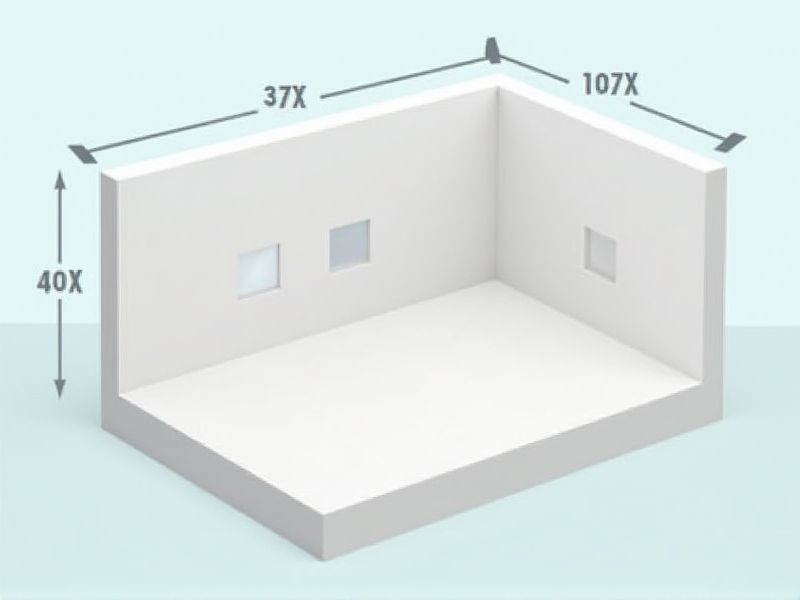
When planning a countertop, it's helpful to know common standard dimensions for a smooth installation. Most countertops are 24 inches deep, which accommodates standard base cabinets and allows enough workspace. The ideal countertop height is typically 36 inches from the floor, making it comfortable for most tasks. Standard lengths vary, but slabs often come in 8- to 10-foot increments, and overhangs are generally 1 to 1.5 inches to provide a finished look and practical function.
Depth
The standard depth for kitchen countertops typically measures 25 inches (63.5 cm), providing ample workspace for meal preparation and cooking. This depth accommodates most kitchen appliances, ensuring they fit seamlessly while allowing for comfortable movement. If you're considering custom designs, deeper countertops of up to 30 inches (76.2 cm) can enhance functionality, especially in larger kitchens. Remember, the depth you choose influences both aesthetic appeal and practical usability in your cooking environment.
Length
The standard length of countertop sections in residential kitchens typically ranges from 96 to 120 inches, accommodating various kitchen layouts and configurations. Custom lengths can also be designed, allowing you to maximize workspace efficiency based on your specific needs. A standard depth is usually 25 inches, providing ample surface area for food preparation and appliances. When considering materials, options like granite, quartz, and laminate offer durability and aesthetic appeal, impacting both functionality and design.
Thickness
The standard thickness for kitchen countertops typically ranges from 1.5 inches to 3 inches, significantly affecting durability and aesthetics. A thickness of 2 centimeters is common for modern quartz and granite options, providing a sleek look while ensuring sturdy performance. In contrast, thicker slabs, measuring up to 3 inches, can offer enhanced stability and a more luxurious appearance. When selecting a countertop, consider how thickness contributes not only to visual appeal but also to the material's resistance to chips and cracks.
Overhang
The standard countertop overhang typically ranges from 1 to 1.5 inches, providing a functional space for dining and preparation. A 12-inch overhang is recommended for bar-style seating, offering enough room for leg clearance while ensuring stability. For kitchen islands, a 2-inch overhang is ideal to create a seamless transition between the countertop and cabinetry. You should also consider materials like granite or quartz, which can support heavier overhangs compared to laminate or wood countertops.
Backsplash Height
The recommended backsplash height for kitchen countertops typically ranges from 4 to 6 inches, ensuring both functionality and aesthetic appeal. However, for a more modern look, many homeowners opt for a full-height backsplash, which can extend from the countertop to the underside of the upper cabinets, usually measuring around 18 to 24 inches. When selecting materials, consider durable options like ceramic tile, glass, or natural stone, which can resist moisture and stains. Your choice of backsplash height and material can impact the overall design and maintenance of your kitchen space.
Edge Style
The edge style of a countertop significantly impacts both aesthetics and functionality, influencing the overall design of your kitchen or bathroom. Popular edge profiles include the elegant Eased edge, the sophisticated Bullnose, and the modern Bevel edge, each providing unique visual appeal and safety features. For instance, a Bullnose edge eliminates sharp corners, making it ideal for families with young children. When selecting an edge style, consider how it complements your countertops' material, whether it be granite, quartz, or laminate, ensuring a seamless integration into your space.
Material Type
Countertops are predominantly made from various materials, including natural stones like granite and marble, and engineered materials such as quartz and laminate. Granite countertops, known for their durability and unique patterns, typically range from $40 to $100 per square foot. Alternatively, quartz countertops, which combine natural stone with resin, offer a non-porous surface and pricing from $50 to $150 per square foot. When selecting a countertop, consider the maintenance requirements, aesthetic appeal, and cost-effectiveness of each material type to match your kitchen or bathroom design.
Cutout Spaces
Countertop cutouts are essential for functionality and aesthetics in kitchen design, with standard dimensions often ranging between 24 to 30 inches in width. Common cutout shapes accommodate sinks, cooktops, and faucets, each requiring precise measurements to ensure a seamless fit. For instance, a standard sink cutout typically measures 30 by 22 inches, while a cooktop cutout usually measures 30 by 20 inches. Ensuring accuracy in these cutout spaces not only enhances your countertop's appearance but also contributes to the overall efficiency of your kitchen layout.
Sink Size And Placement
When selecting a countertop, the sink size and placement play crucial roles in functionality and aesthetics. Standard sink dimensions typically range from 22 to 33 inches in width, with depth spanning 16 to 20 inches. Proper placement is essential, with an ideal distance of 24 to 36 inches from the edge of the countertop to allow for comfortable usability. Elevating your kitchen design with the right sink configuration can enhance both efficiency and visual appeal, making it a key consideration in your renovation plans.
Appliance Accommodation
Selecting a countertop that accommodates appliances effectively is crucial for maximizing your kitchen efficiency. For instance, a countertop height of 36 inches is standard, allowing comfortable access to most kitchen appliances. Ensure that your countertop has specific power outlets and ample space for small appliances such as blenders or toasters, ideally at least 18 inches of clear counter space on each side. When choosing materials, consider options like quartz or granite, which not only support appliance weight but also resist stains and heat, enhancing both durability and functionality.
